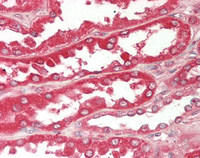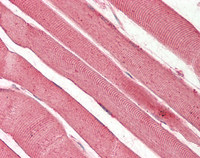Anti-RAB7A / RAB7 Antibody (C-Terminus)
Goat Anti Mouse Polyclonal Antibody
- 产品详情
- 实验流程
Application
| WB, IHC-P, IF |
|---|---|
| Primary Accession | P51149 |
| Predicted | Human, Mouse, Rat, Monkey, Dog |
| Host | Goat |
| Clonality | Polyclonal |
| Isotype | IgG |
| Calculated MW | 23490 Da |
| Concentration (mg/ml) | 3 mg/ml |
| Gene ID | 7879 |
|---|---|
| Alias Symbol | RAB7A |
| Other Names | RAB7A, CMT2B, PRO2706, RAB7, Ras-associated protein RAB7, Ras-related protein Rab-7a, PSN |
| Target/Specificity | Detects Rab7a protein in the human, rat and mouse whole cell lysates and transfected cells with GFP-Rab7a by Western blot. This Ab is specific for Rab7a. |
| Reconstitution & Storage | PBS, 20% glycerol, 0.05% sodium azide. Long term: -20°C; Short term: +4°C; Avoid freeze-thaw cycles. |
| Precautions | Anti-RAB7A / RAB7 Antibody (C-Terminus) is for research use only and not for use in diagnostic or therapeutic procedures. |
| Name | RAB7A (HGNC:9788) |
|---|---|
| Synonyms | RAB7 |
| Function | The small GTPases Rab are key regulators of intracellular membrane trafficking, from the formation of transport vesicles to their fusion with membranes. Rabs cycle between an inactive GDP-bound form and an active GTP-bound form that is able to recruit to membranes different sets of downstream effectors directly responsible for vesicle formation, movement, tethering and fusion (PubMed:38538795). In its active state, RAB7A binds to a variety of effector proteins playing a key role in the regulation of endo-lysosomal trafficking. Governs early-to-late endosomal maturation, microtubule minus-end as well as plus-end directed endosomal migration and positioning, and endosome- lysosome transport through different protein-protein interaction cascades. Also plays a central role in growth-factor-mediated cell signaling, nutrient-transportor mediated nutrient uptake, neurotrophin transport in the axons of neurons and lipid metabolism. Also involved in regulation of some specialized endosomal membrane trafficking, such as maturation of melanosomes, pathogen-induced phagosomes (or vacuoles) and autophagosomes. Plays a role in the maturation and acidification of phagosomes that engulf pathogens, such as S.aureus and M.tuberculosis. Plays a role in the fusion of phagosomes with lysosomes. In concert with RAC1, plays a role in regulating the formation of RBs (ruffled borders) in osteoclasts. Controls the endosomal trafficking and neurite outgrowth signaling of NTRK1/TRKA (PubMed:11179213, PubMed:12944476, PubMed:14617358, PubMed:20028791, PubMed:21255211). Regulates the endocytic trafficking of the EGF-EGFR complex by regulating its lysosomal degradation. Involved in the ADRB2-stimulated lipolysis through lipophagy, a cytosolic lipase-independent autophagic pathway (By similarity). Required for the exosomal release of SDCBP, CD63 and syndecan (PubMed:22660413). Required for vesicular trafficking and cell surface expression of ACE2 (PubMed:33147445). May play a role in PRPH neuronal intermediate filament assembly (By similarity). |
| Cellular Location | Cytoplasmic vesicle, phagosome membrane; Peripheral membrane protein; Cytoplasmic side. Late endosome membrane; Peripheral membrane protein; Cytoplasmic side Lysosome membrane; Peripheral membrane protein; Cytoplasmic side Melanosome membrane; Peripheral membrane protein; Cytoplasmic side. Cytoplasmic vesicle, autophagosome membrane; Peripheral membrane protein; Cytoplasmic side. Lipid droplet {ECO:0000250|UniProtKB:P51150}. Endosome membrane; Peripheral membrane protein. Cytoplasmic vesicle {ECO:0000250|UniProtKB:P51150} Mitochondrion membrane; Peripheral membrane protein. Note=Colocalizes with OSBPL1A at the late endosome (PubMed:16176980). Found in the ruffled border (a late endosomal-like compartment in the plasma membrane) of bone-resorbing osteoclasts. Recruited to phagosomes containing S.aureus or Mycobacterium (PubMed:21255211). Lipid droplet localization is increased upon ADRB2 stimulation (By similarity). Recruited to damaged mitochondria during mitophagy in a RIMOC1-dependent manner (PubMed:34432599). {ECO:0000250|UniProtKB:P51150, ECO:0000269|PubMed:16176980, ECO:0000269|PubMed:21255211, ECO:0000269|PubMed:34432599} |
| Tissue Location | Widely expressed; high expression found in skeletal muscle. |
Research Areas
For Research Use Only. Not For Use In Diagnostic Procedures.
Application Protocols
Provided below are standard protocols that you may find useful for product applications.
终于等到您。ABCEPTA(百远生物)抗体产品。
点击下方“我要评价 ”按钮提交您的反馈信息,您的反馈和评价是我们最宝贵的财富之一,
我们将在1-3个工作日内处理您的反馈信息。
如有疑问,联系:0512-88856768 tech-china@abcepta.com.
¥ 4,380.00
Cat# ALS17334























 癌症的基本特征包括细胞增殖、血管生成、迁移、凋亡逃避机制和细胞永生等。找到癌症发生过程中这些通路的关键标记物和对应的抗体用于检测至关重要。
癌症的基本特征包括细胞增殖、血管生成、迁移、凋亡逃避机制和细胞永生等。找到癌症发生过程中这些通路的关键标记物和对应的抗体用于检测至关重要。 为您推荐一个泛素化位点预测神器——泛素化分析工具,可以为您的蛋白的泛素化位点作出预测和评分。
为您推荐一个泛素化位点预测神器——泛素化分析工具,可以为您的蛋白的泛素化位点作出预测和评分。 细胞自噬受体图形绘图工具为你的蛋白的细胞受体结合位点作出预测和评分,识别结合到自噬通路中的蛋白是非常重要的,便于让我们理解自噬在正常生理、病理过程中的作用,如发育、细胞分化、神经退化性疾病、压力条件下、感染和癌症。
细胞自噬受体图形绘图工具为你的蛋白的细胞受体结合位点作出预测和评分,识别结合到自噬通路中的蛋白是非常重要的,便于让我们理解自噬在正常生理、病理过程中的作用,如发育、细胞分化、神经退化性疾病、压力条件下、感染和癌症。







